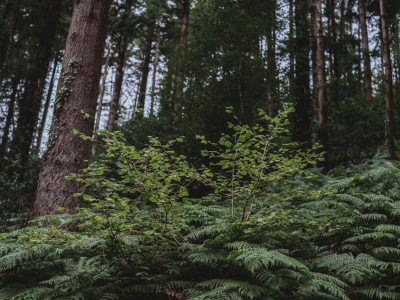
Sustainable Woodland Management AIM Level 3
- The Green Wood Centre
- 05 Aug 2025 - 07 Aug 2025
3 Awst 2023
Our members recently enjoyed a fascinating visit to Norbury Park and the BIFor FACE research institute in Staffordshire. These two sites are alongside each other on the Norbury Park Estate, which is owned by Drs Jo and Barbara Bradwell. Jo gave us a wonderful introduction and then showed us around some sites on the estate, which gave us lots of talking points.
Jo is very focused on the objective of increasing rates of carbon sequestration through the trees planted on the estate, and is experimenting with a range of different mixes of both native and non-native species. One of the most innovative approaches is halo pollarding, where a “winner” is chosen within a young plantation and the trees immediately around it are pollarded at around 2m. Thanks to this and other techniques, the estate claims to be carbon positive, partly due to significantly enhanced growth rates from their approach.
The estate is also experimenting with squirrel control and has developed a variant of the Kania trap. This should make trapping far more cost effective, as it removes the need to check traps every day. Initial trials have been positive and if it proves successful, they may be more generally available next year.
The afternoon was spent at the FACE (Free Air Carbon Enrichment) research facility - one of a small number of experimental facilities around the world that are examining the responses of trees and woodlands to elevated CO2 levels. This is only the second facility of its type anywhere and the only one in the northern hemisphere. The facility is pumping CO2 into the canopy of a mature oak woodland with hazel/mixed understorey.
The CO2 levels being aimed for are those thought to be likely by 2050, about 38% higher than we experience today. The research site is 7 years into what is hoped will be at least a 20 year programme. There are dozens of separate experimental projects looking at everything from the direct canopy response and tree growth, down to the litter and sub soil level responses, as well as the plants and animals associated with the wood. The facility provides the ability to test what the models are predicting, in a real woodland environment and should provide early warning of likely consequences of heightened CO2.
Both sites are bold steps in the face of climate change and served as an inspiration to the members on the visit. Dr Bradwell commented at the end of the day that it was obvious that our members are as passionate about their woods, as Jo is about his. Some cross fertilisation of ideas may very well result.
Join us! The benefits of becoming a member include:
- Online resources, including a regular e-newsletter on our activities and news from the woodland sector
- Members’ visits and training events, giving you the opportunity to learn about woodlands and meet other members.
- 20% off all training courses
- Quarterly Smallwoods magazine packed full of articles on sustainable woodland management
Become a member here.